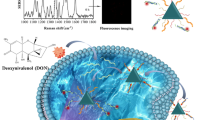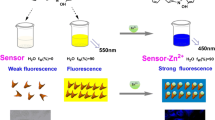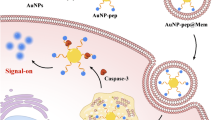Abstract
T-2 toxin, one of the most dangerous natural pollutants, induces apoptosis through multiple pathways. Amongst, P53 mediated apoptosis pathway, an important collection of molecules, plays a key role in cell vital activity. Real-time monitoring of upstream and downstream activation relationships of P53 mRNA, Bax mRNA, and cytochrome c (Cyt c) in signaling pathways is of great significance for understanding the apoptotic machinery in human physiology. In this work, a novel nucleic acid multicolor fluorescent probe, based on silica-coated symmetric gold nanostars (S-AuNSs@SiO2), was developed for highly sensitive in situ real-time imaging of P53 mRNA, Bax mRNA, and Cyt c during T-2 toxin-induced apoptosis. The nucleic acid chains modified with carboxyl groups were modified on the surface of S-AuNSs@SiO2 by amide reaction. The complementary chains of targeted mRNA and the aptamer of targeted Cyt c were modified with different fluorophores, respectively, and successfully hybridized on S-AuNSs@SiO2 surface. When targets were present, the fluorescent chains bound to the targets and detached from the material, resulting in the quenched fluorescence being revived. The probes based on S-AuNSs showed excellent performance is partly ascribed to the presence of 20 symmetric “hot spots”. Notably, the amide-bonded probe exhibited excellent anti-interference capability against biological agents (nucleases and biothiols). During the real-time fluorescence imaging of T-2 toxin-induced apoptosis, the corresponding fluorescence signals of P53 mRNA, Bax mRNA, and Cyt c were observed sequentially. Therefore, S-AuNSs@SiO2 probe not only provides a novel tool for real-time monitoring of apoptosis pathways cascade but also has considerable potential in disease diagnosis and pharmaceutical medical.

Similar content being viewed by others
References
Vidal, A.; Mengelers, M.; Yang, S. P.; De Saeger, S.; De Boevre, M. Mycotoxin biomarkers of exposure: A comprehensive review. Compr. Rev. Food Sci. Food Saf. 2018, 17, 1127–1155.
Yang, X.; Zhang, X. L.; Zhang, J.; Ji, Q.; Huang, W. Y.; Zhang, X. Y.; Li, Y. F. Spermatogenesis disorder caused by T-2 toxin is associated with germ cell apoptosis mediated by oxidative stress. Environ. Pollut. 2019, 251, 372–379.
Dai, C. S.; **ao, X. L.; Sun, F. F.; Zhang, Y.; Hoyer, D.; Shen, J. Z.; Tang, S. S.; Velkov, T. T-2 toxin neurotoxicity: Role of oxidative stress and mitochondrial dysfunction. Arch. Toxicol. 2019, 93, 3041–3056.
Yang, X.; Liu, P. L.; Zhang, X. L.; Zhang, J.; Cui, Y. L.; Song, M.; Li, Y. F. T-2 toxin causes dysfunction of Sertoli cells by inducing oxidative stress. Ecotoxicol. Environ. Saf. 2021, 225, 112702.
Nagata, S.; Tanaka, M. Programmed cell death and the immune system. Nat. Rev. Immunol. 2017, 17, 333–340.
Elmore, S. Apoptosis: A review of programmed cell death. Toxicol. Pathol. 2007, 35, 495–516.
Del Re, D. P.; Amgalan, D.; Linkermann, A.; Liu, Q. H.; Kitsis, R. N. Fundamental mechanisms of regulated cell death and implications for heart disease. Physiol. Rev. 2019, 99, 1765–1817.
**a, P.; Liu, Y. N.; Cheng, Z. K. Signaling pathways in cardiac myocyte apoptosis. BioMed Res. Int. 2016, 2016, 9583268.
Yang, F.; Liao, J. Z.; Yu, W. L.; Qiao, N.; Guo, J. Y.; Han, Q. Y.; Li, Y.; Hu, L. M.; Pan, J. Q.; Tang, Z. X. Exposure to copper induces mitochondria-mediated apoptosis by inhibiting mitophagy and the PINK1/parkin pathway in chicken (Gallus gallus) livers. J. Hazard. Mater. 2021, 408, 124888.
Wei, H. D.; Qu, L. Z.; Dai, S. Y.; Li, Y.; Wang, H. L.; Feng, Y. L.; Chen, X. J.; Jiang, L. Y.; Guo, M.; Li, J. et al. Structural insight into the molecular mechanism of p53-mediated mitochondrial apoptosis. Nat. Commun. 2021, 12, 2280.
Atatreh, N.; Ghattas, M. A.; Bardaweel, S. K.; Al Rawashdeh, S.; Al Sorkhy, M. Identification of new inhibitors of Mdm2-p53 interaction via pharmacophore and structure-based virtual screening. Drug Des. Dev. Ther. 2018, 12, 3741–3752.
Cosentino, K.; García-Sáez, A. J. Bax and bak pores: Are we closing the circle? Trends Cell Biol. 2017, 27, 266–275.
Chipuk, J. E.; Kuwana, T.; Bouchier-Hayes, L.; Droin, N. M.; Newmeyer, D. D.; Schuler, M.; Green, D. R. Direct activation of Bax by p53 mediates mitochondrial membrane permeabilization and apoptosis. Science 2004, 303, 1010–1014.
Tang, J.; Song, M. Y.; Watanabe, G.; Nagaoka, K.; Rui, X. L.; Li, C. M. Effects of 4-nitrophenol on expression of the ER-α and AhR signaling pathway-associated genes in the small intestine of rats. Environ. Pollut. 2016, 216, 27–37.
Han, Z. Q.; Liu, D. M.; Chen, L.; He, Y. C.; Tian, X. D.; Qi, L. S.; Chen, L. W.; Luo, Y.; Chen, Z. Y.; Hu, X. M. et al. PNO1 regulates autophagy and apoptosis of hepatocellular carcinoma via the MAPK signaling pathway. Cell Death Dis. 2021, 12, 552.
Sun, G.; Ma, B.; Guo, W. J.; Shan, M. H.; Ma, B. L. BRCA1 subcellular localization regulated by PI3K signaling pathway in triple negative breast cancer MDA-MB-231 cells and hormone-sensitve T47D cells. J. Clin. Oncol. 2018, 36, e13115.
Kirsanov, K.; Fetisov, T.; Lesovaya, E. A.; Maksimova, V.; Trukhanova, L.; Antoshina, E.; Gor’kova, T.; Morozova, O.; Safina, A.; Fleyshman, D. et al. Prevention of colorectal carcinogenesis by DNA-binding small-molecule curaxin CBL0137 involves suppression of Wnt signaling. Cancer Prev. Res. 2020, 13, 53–64.
Chen, X. X.; Niu, L. Y.; Yang, Q. Z. Visualizing the underlying signaling pathway related to nitric oxide and glutathione in cardiovascular disease therapy by a sequentially activated fluorescent probe. Anal. Chem. 2021, 93, 3922–3928.
Hang, Y. J.; Boryczka, J.; Wu, N. Q. Visible-light and near-infrared fluorescence and surface-enhanced Raman scattering point-of-care sensing and bio-imaging: A review. Chem. Soc. Rev. 2022, 51, 329–375.
Gao, X. N.; Li, J.; Luan, M. M.; Li, Y. H.; Pan, W.; Li, N.; Tang, B. Real-time in situ monitoring of signal molecules’ evolution in apoptotic pathway via Au−Se bond constructed nanoprobe. Biosens. Bioelectron. 2020, 147, 111755.
Kyriazi, M. E.; Giust, D.; El-Sagheer, A. H.; Lackie, P. M.; Muskens, O. L.; Brown, T.; Kanaras, A. G. Multiplexed mRNA sensing and combinatorial-targeted drug delivery using DNA-gold nanoparticle dimers. ACS Nano 2018, 12, 3333–3340.
Zhu, R.; Li, J.; Lin, L. S.; Song, J. B.; Yang, H. H. Emerging plasmonic assemblies triggered by DNA for biomedical applications. Adv. Funct. Mater. 2021, 31, 2005709.
Gao, Y. S.; Zhang, S. B.; Wu, C. W.; Li, Q.; Shen, Z. F.; Lu, Y.; Wu, Z. S. Self-protected DNAzyme walker with a circular bulging DNA shield for amplified imaging of miRNAs in living cells and mice. ACS Nano 2021, 15, 19211–19224.
Hu, B.; Kong, F. P.; Gao, X. N.; Jiang, L. L.; Li, X. F.; Gao, W.; Xu, K. H.; Tang, B. Avoiding thiol compound interference: A nanoplatform based on high-fidelity Au−Se bonds for biological applications. Angew. Chem., Int. Ed. 2018, 57, 5306–5309.
Yang, Y. J.; Huang, J.; Yang, X. H.; Quan, K.; Wang, H.; Ying, L.; **e, N. L.; Ou, M.; Wang, K. M. FRET nanoflares for intracellular mRNA detection: Avoiding false positive signals and minimizing effects of system fluctuations. J. Am. Chem. Soc. 2015, 137, 8340–8343.
Chaudhari, M. B.; Gnanaprakasam, B. Recent advances in the metal-catalyzed activation of amide bonds. Chem. Asian J. 2019, 14, 76–93.
Souza, B. S.; Mora, J. R.; Wanderlind, E. H.; Clementin, R. M.; Gesser, J. C.; Fiedler, H. D.; Nome, F.; Menger, F. M. Transforming a stable amide into a highly reactive one: Capturing the essence of enzymatic catalysis. Angew. Chem., Int. Ed. 2017, 56, 5345–5348.
Pill, M. F.; East, A. L. L.; Marx, D.; Beyer, M. K.; Clausen-Schaumann, H. Mechanical activation drastically accelerates amide bond hydrolysis, matching enzyme activity. Angew. Chem., Int. Ed. 2019, 58, 9787–9790.
Mrówczyński, R. Polydopamine-based multifunctional (nano)materials for cancer therapy. ACS Appl. Mater. Interfaces 2018, 10, 7541–7561.
Yang, L. T.; Kim, T. H.; Cho, H. Y.; Luo, J.; Lee, J. M.; Chueng, S. T. D.; Hou, Y. N.; Yin, P. T.; Han, J. Y.; Kim, J. H. et al. Hybrid graphene-gold nanoparticle-based nucleic acid conjugates for cancer-specific multimodal imaging and combined therapeutics. Adv. Funct. Mater. 2021, 31, 2006918.
Niu, W. X.; Chua, Y. A. A.; Zhang, W. Q.; Huang, H. J.; Lu, X. M. Highly symmetric gold nanostars: Crystallographic control and surface-enhanced Raman scattering property. J. Am. Chem. Soc. 2015, 137, 10460–10463.
Li, S. S.; Kong, Q. Y.; Zhang, M.; Yang, F.; Kang, B.; Xu, J. J.; Chen, H. Y. Plasmon-resonance-energy-transfer-based spectroscopy on single nanoparticles: Biomolecular recognition and enzyme kinetics. Anal. Chem. 2018, 90, 3833–3841.
Ahmad, N.; Wang, G.; Nelayah, J.; Ricolleau, C.; Alloyeau, D. Exploring the formation of symmetric gold nanostars by liquid-cell transmission electron microscopy. Nano Lett. 2017, 17, 4194–4201.
Dondapati, S. K.; Sau, T. K.; Hrelescu, C.; Klar, T. A.; Stefani, F. D.; Feldmann, J. Label-free biosensing based on single gold nanostars as plasmonic transducers. ACS Nano 2010, 4, 6318–6322.
Luo, G. F.; Chen, W. H.; Lei, Q.; Qiu, W. X.; Liu, Y. X.; Cheng, Y. J.; Zhang, X. Z. A Triple-collaborative strategy for high-performance tumor therapy by multifunctional mesoporous silica-coated gold nanorods. Adv. Funct. Mater. 2016, 26, 4339–4350.
Walters, C. M.; Pao, C.; Gagnon, B. P.; Zamecnik, C. R.; Walker, G. C. Bright Surface-enhanced Raman scattering with fluorescence quenching from silica encapsulated J-aggregate coated gold nanoparticles. Adv. Mater. 2018, 30, 1705381.
Blanco-Formoso, M.; Sousa-Castillo, A.; **ao, X. F.; Marino-Lopez, A.; Turino, M.; Pazos-Perez, N.; Giannini, V.; Correa-Duarte, M. A.; Alvarez-Puebla, R. A. Boosting the analytical properties of gold nanostars by single particle confinement into yolk porous silica shells. Nanoscale 2019, 11, 21872–21879.
Zhou, J. L.; Zhao, R. X.; Liu, S. K.; Feng, L. L.; Li, W. T.; He, F.; Gai, S. L.; Yang, P. P. Europium doped silicon quantum dot As a novel FRET based dual detection probe: Sensitive detection of tetracycline, zinc, and cadmium. Small Methods 2021, 5, 2100812.
Wang, D.; Chen, J.; Ren, L.; Li, Q. L.; Li, D. D.; Yu, J. H. AIEgen-functionalised mesoporous silica nanoparticles as a FRET donor for monitoring drug delivery. Inorg. Chem. Front. 2017, 4, 468–472.
An, H. Y.; Song, Z. M.; Li, P.; Wang, G.; Ma, B. Q.; Wang, X. P. Development of biofabricated gold nanoparticles for the treatment of alleviated arthritis pain. Appl. Nanosci. 2019, 10, 617–622.
Biao, L. H.; Tan, S. N.; Meng, Q. H.; Gao, J.; Zhang, X. W.; Liu, Z. G.; Fu, Y. J. Green synthesis, characterization and application of proanthocyanidins-functionalized gold nanoparticles. Nanomaterials 2018, 8, 53.
Verma, D.; Sharma, V.; Okram, G. S.; Jain, S. Ultrasound-assisted high-yield multicomponent synthesis of triazolo[1,2-a]indazole-triones using silica-coated ZnO nanoparticles as a heterogeneous catalyst. Green Chem. 2017, 19, 5885–5899.
Hosseinzadeh, S. Z.; Babazadeh, M.; Shahverdizadeh, G. H.; Es’haghi, M.; Hosseinzadeh-Khanmiri, R. Silica encapsulated-gold nanoparticles as a nano-reactor for aerobic oxidation of benzyl alcohols and tandem oxidative A3 coupling reactions in water. Catal. Lett. 2020, 150, 2784–2791.
Brum, L. F. W.; Dos Santos, C.; Zimnoch Santos, J. H.; Brandelli, A. Structured silica materials as innovative delivery systems for the bacteriocin nisin. Food Chem. 2022, 366, 130599.
Zhang, L. P.; Zhou, Y. M.; Shi, G.; Sang, X. X.; Ni, C. H. Preparations of hyperbranched polymer nano micelles and the pH/redox controlled drug release behaviors. Mater. Sci. Eng. C 2017, 79, 116–122.
Li, Y. J.; Hei, M. Y.; Xu, Y. F.; Qian, X. H.; Zhu, W. P. Ammonium salt modified mesoporous silica nanoparticles for dual intracellular-responsive gene delivery. Int. J. Pharm. 2016, 511, 689–702.
Lv, Y.; Li, J.; Chen, H.; Bai, Y.; Zhang, L. Glycyrrhetinic acid-functionalized mesoporous silica nanoparticles as hepatocellular carcinoma-targeted drug carrier. Int. J. Nanomed. 2017, 12, 4361–4370.
de Q. Silveira, G.; Chen, Z. W.; Barry, E. F.; Diroll, B. T.; Lee, B.; Rajh, T.; Rozhkova, E. A.; Laible, P. D.; Fry, H. C. Energy transfer induced by dye encapsulation in a hybrid nanoparticle-purple membrane reversible assembly. Adv. Funct. Mater. 2019, 29, 1904899.
Simoncelli, S.; Makarova, M.; Wardley, W.; Owen, D. M. Toward an axial nanoscale ruler for fluorescence microscopy. ACS Nano 2017, 11, 11762–11767.
Wang, N. N.; Li, J.; He, B. S.; Deng, T.; Yang, J. F.; Li, J. S. Two-photon excitation nanoprobe for DNases activity imaging assay in hepatic ischemia reperfusion injury. Sens. Actuators B Chem. 2019, 298, 126853.
Tamkovich, S. N.; Cherepanova, A. V.; Kolesnikova, E. V.; Rykova, E. Y.; Pyshnyi, D. V.; Vlassov, V. V.; Laktionov, P. P. Circulating DNA and DNase activity in human blood. Ann. N. Y. Acad. Sci. 2006, 1075, 191–196.
Seferos, D. S.; Giljohann, D. A.; Hill, H. D.; Prigodich, A. E.; Mirkin, C. A. Nano-flares: Probes for transfection and mRNA detection in living cells. J. Am. Chem. Soc. 2007, 129, 15477–15479.
Rosi, N. L.; Giljohann, D. A.; Thaxton, C. S.; Lytton-Jean, A. K. R.; Han, M. S.; Mirkin, C. A. Oligonucleotide-modified gold nanoparticles for intracellular gene regulation. Science 2006, 312, 1027–1030.
Liu, B.; Zhou, P.; Wang, K. Y.; Gong, S. H.; Luan, M. M.; Li, N.; Tang, B. Avoiding false positive signals: A powerful and reliable Au−Se dual-color probe. ACS Sens. 2021, 6, 1949–1955.
Qing, Z. H.; Luo, G. Y.; **ng, S. H.; Zou, Z.; Lei, Y. L.; Liu, J. W.; Yang, R. H. Pt−S bond-mediated nanoflares for high-fidelity intracellular applications by avoiding thiol cleavage. Angew. Chem., Int. Ed. 2020, 59, 14044–14048.
He, B. S.; Dong, X. Z. Hierarchically porous Zr-MOFs labelled methylene blue as signal tags for electrochemical patulin aptasensor based on ZnO nano flower. Sens. Actuator, B Chim. 2019, 294, 192–198.
Chen, S.; Liu, P.; Su, K. W.; Li, X.; Qin, Z.; Xu, W.; Chen, J.; Li, C. R.; Qiu, J. F. Electrochemical aptasensor for thrombin using co-catalysis of hemin/G-quadruplex DNAzyme and octahedral Cu2O−Au nanocomposites for signal amplification. Biosens. Bioelectron. 2018, 99, 338–345.
Zhang, H. J.; Kou, Y. M.; Li, J. B.; Chen, L.; Mao, Z.; Han, X. X.; Zhao, B.; Ozaki, Y. Nickel nanowires combined with surface-enhanced Raman spectroscopy: Application in label-free detection of cytochrome c-mediated apoptosis. Anal. Chem. 2019, 91, 1213–1216.
Li, N.; Chang, C. Y.; Pan, W.; Tang, B. A multicolor nanoprobe for detection and imaging of tumor-related mRNAs in living cells. Angew. Chem. 2012, 124, 7544–7548.
Zhong, L.; Cai, S. X.; Huang, Y. D.; Yin, L. T.; Yang, Y. L.; Lu, C. H.; Yang, H. H. DNA octahedron-based fluorescence nanoprobe for dual tumor-related mRNAs detection and imaging. Anal. Chem. 2018, 90, 12059–12066.
Wang, Y.; Li, Z. H.; Liu, M. S.; Xu, J. J.; Hu, D. H.; Lin, Y. H.; Li, J. H. Multiple-targeted graphene-based nanocarrier for intracellular imaging of mRNAs. Anal. Chim. Acta 2017, 983, 1–8.
Li, C. B.; Chen, P. F.; Khan, I. M.; Wang, Z. P.; Zhang, Y.; Ma, X. Y. Fluorescence-Raman dual-mode quantitative detection and imaging of small-molecule thiols in cell apoptosis with DNA-modified gold nanoflowers. J. Mater. Chem. B 2022, 10, 571–581.
Daniyal, M.; Liu, Y. B.; Yang, Y. P.; **ao, F.; Fan, J. L.; Yu, H. H.; Qiu, Y. X.; Liu, B.; Wang, W.; Yuhui, Q. Anti-gastric cancer activity and mechanism of natural compound “Heilaohulignan C” isolated from Kadsura coccinea. Phytother. Res. 2021, 35, 3977–3987.
Kaparekar, P. S.; Poddar, N.; Anandasadagopan, S. K. Fabrication and characterization of Chrysin—A plant polyphenol loaded alginate-chitosan composite for wound healing application. Colloids Surf. B Biointerfaces 2021, 206, 111922.
Kim, E. M.; Jung, C. H.; Kim, J.; Hwang, S. G.; Park, J. K.; Um, H. D. The p53/p21 complex regulates cancer cell invasion and apoptosis by targeting Bcl-2 family proteins. Cancer Res. 2017, 77, 3092–3100.
Follis, A. V.; Llambi, F.; Merritt, P.; Chipuk, J. E.; Green, D. R.; Kriwacki, R. W. Pin1-induced proline isomerization in cytosolic p53 mediates BAX activation and apoptosis. Mol. Cell 2015, 59, 677–684.
Xu, F. B.; Li, Y. F.; Cao, Z.; Zhang, J.; Huang, W. Y. AFB1-induced mice liver injury involves mitochondrial dysfunction mediated by mitochondrial biogenesis inhibition. Ecotoxicol. Environ. Saf. 2021, 216, 112213.
Acknowledgements
We are grateful for the financial support from the Jiangsu Agriculture Science and Technology Innovation Fund (No. CX (19)2005) and the Social Development Fund Project of Wuxi (No. N20201001).
Author information
Authors and Affiliations
Corresponding author
Electronic Supplementary Material
12274_2022_5069_MOESM1_ESM.pdf
Real-time in situ observation of P53-mediated cascade activation of apoptotic pathways with nucleic acid multicolor fluorescent probes based on symmetrical gold nanostars
Rights and permissions
About this article
Cite this article
Li, C., Chen, P., Ma, X. et al. Real-time in situ observation of P53-mediated cascade activation of apoptotic pathways with nucleic acid multicolor fluorescent probes based on symmetrical gold nanostars. Nano Res. 16, 5391–5400 (2023). https://doi.org/10.1007/s12274-022-5069-9
Received:
Revised:
Accepted:
Published:
Issue Date:
DOI: https://doi.org/10.1007/s12274-022-5069-9




